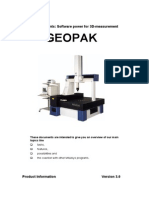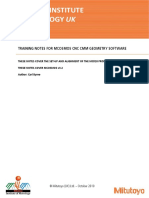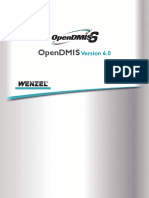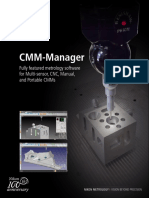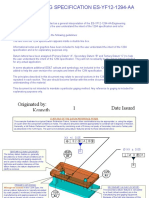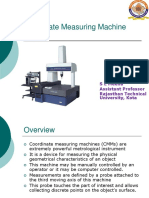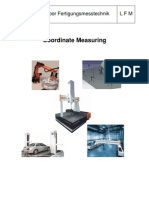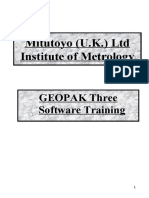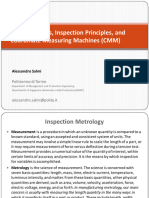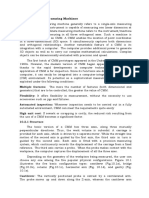Coordinate Measuring Machine (CMM)
Coordinate Measuring Machine (CMM)
Uploaded by
nurul ainiCopyright:
Available Formats
Coordinate Measuring Machine (CMM)
Coordinate Measuring Machine (CMM)
Uploaded by
nurul ainiCopyright
Available Formats
Share this document
Did you find this document useful?
Is this content inappropriate?
Copyright:
Available Formats
Coordinate Measuring Machine (CMM)
Coordinate Measuring Machine (CMM)
Uploaded by
nurul ainiCopyright:
Available Formats
Coordinate Measuring
Machine (CMM)
http://en.wikipedia.org/wiki/Coordinate-measuring_machine
KAMARUL ADNAN
Learning Outcomes
At the end of this lesson, students will
be able to:
Describe the principle of CMM.
State the applications of CMM.
Explain the operating methods of CMM.
Introduction
A 'coordinate measuring machine' (CMM) is
a device for measuring the physical
geometrical characteristics of an object.
This machine may be manually controlled
by an operator or it may be computer
controlled.
Introduction (Contd)
CMM
Introduction (Contd)
CMM
Introduction (Contd)
Measurements are defined by a probe
attached to the third moving axis of this
machine.
This probe touches the part of interest and
allows collecting discrete points on the
object's surface.
Introduction (Contd)
Probe
Introduction (Contd)
Methods of probing
Introduction (Contd)
The typical CMM is composed of three axes,
an X, Y and Z.
These axes are orthogonal to each other in
a typical three dimensional coordinate
system.
Each axis has a very accurate scale system
that indicates the location of that axis.
All three axes are displayed on a digital
readout.
Introduction (Contd)
Reverse
Engineering
Propeller model being
probed so that a 3D
CAD drawing of the
surfaces could be
obtained.
Introduction (Contd)
Quality Control
CMM used to verify
dimensions of
machined features
Introduction (Contd)
A coordinate measuring machine (CMM) is
also a device used in manufacturing and
assembly processes to test a part or
assembly against the design intent.
By precisely recording the X, Y, and Z
coordinates of the target, points are
generated which can then be analyzed via
regression algorithms for the construction of
features.
Introduction (Contd)
These points are collected by using a probe
that is positioned manually by an operator or
automatically via Direct Computer Control
(DCC).
Parts Of CMM Machine
Coordinate-measuring machines include
three main components:
The main structure which include three
axes of motion
Probing system
Data collection and Reduction system typically includes a machine controller,
desktop computer and application
software.
Parts (Contd)
Moving Bridge Coordinate
Measuring Machine
Fixed Bridge Coordinate
Measuring Machine
Parts (Contd)
Fixed Table Cantilever
Coordinate Measuring
Machine
Column Coordinate
Measuring Machine
Parts (Contd)
Probing System
Uses/Applications
They are often used for:
Dimensional measurement
Profile measurement
Angularity or orientation measurement
Depth mapping
Digitizing or imaging
Shaft measurement
Features
They are offered with features like:
Crash protection
Offline programming
Reverse engineering
Shop floor suitability
SPC software and temperature
compensation.
CAD Model import capability
Operation of CMM
On contact, the coordinate position are
recorded by the CMM controller, adjusting
for over travel and probe size.
Positioning of the probe relative to the part
can be accomplished either manually or
under computer control.
Methods of operating a CMM are classified
as i) manual control, ii) manual
computer-assisted, iii) motorized
computer-assisted, and iv) direct
computer control.
Method of OperatingManual Control
In manual control, a human operator physically
moves the probe along the axes to contact the
part and record the measurement.
The probe is free-floating for easy movement.
Measurement are indicated by digital read-out,
and the operator can record the measurement
manually or automatically.
Any trigonometric calculation must be made by
operator.
Method of OperatingManual Computer-Assisted
The
manual computer-assisted CMM is
capable of computer data processing to
perform trigonometric calculations.
Types of computations include determining
hole-centre locations.
The probe is still free floating to permit the
operator to bring it into contact with part
surfaces.
Method of OperatingMotorized Computer-assisted
Motorized
computer-assisted CMMs power
drive the probe along the machine axes
under operator guidance.
A joystick or similar device is used to control
the motion.
Low power stepping motors and friction
clutches are used to reduced the effects of
collisions between probe and part.
Method of OperatingDirect Computer Control
Direct computer-control CMM operation like
a CNC machine tool.
It is computerized inspection machine that
operates under program control.
The computer also records measurements
made during inspection and performs
various calculations associated with certain
measurement (for example, computing the
centre of a hole from three or more points
on the hole surface).
Basic Geometric Elements
Circle:
Requires 3 points for
measurement: By measuring 4
(up to 50) or more points form
deviation is determined
Plane:
Planar measurements require
4 or more points for form. The
intersection of Planes 2 and 3
generate Line 5; Point 6 is the
intersection of Plane 4 and
Line 5
Basic Geometric Elements
Cylinder:
To define a cylinder, 5 points
are necessary. Calculations
provide its axis and diameter.
The intersection of the
Cylinder 7 and Plane 4 is Line
8.
Cone:
The cone (or taper) requires at
least 6 points for definition.
Calculations determine the
cones included angle and its
axis in space.
Basic Geometric Elements
Sphere:
The location of a sphere is
found by measuring 4 points
is also calculated.
CMM Measurements and
Advantages
The basic capability of a CMM is determination of
coordinate values where its probe contacts the
surface of a part.
Computer control permits the CMM to accomplish
more sophisticated measurements and inspections,
such as:
a) determining center location of hole or cylinder
b) definition of a plane
c) measurement of flatness of a surface or
parallelism between two surfaces, and
d) measurement of a angle between two planes.
CMM Measurements and
Advantages
Advantages of using coordinates measuring
machines over manual inspection methods
include:
1) Higher productivity-a CMM can perform complex
inspection procedures in much less time than traditional
manual methods.
2) Greater inherent accuracy and precision than
conventional methods.
3) Reduced human error through automation of the
inspection procedure and associated computations.
A CMM is a general purpose machine that can be
used to inspect a variety of part configuration.
CMM Measurements and
Advantages
A
CMM is a general purpose machine that
can be used to inspect a variety of part
configuration.
Conclusion
With the prices of desktop computer dropping
drastically in the last few years, small
manufacturing firms can afford to own a CMM with
a computer interface.
CMMs are slowly working their way into
automation.
With the major emphasis being on closed loop
process control, CMMs provide the ability to make
precise measurements, using the sophisticated
hardware, and convert this information using
integrated software, into data that is meaningful to
the entire automated system.
You might also like
- Rowdy Dowdy Bunny CrochetDocument28 pagesRowdy Dowdy Bunny CrochetLoredana Mihai100% (14)
- Zeiss Calypso Advanced Filter and OutliersDocument12 pagesZeiss Calypso Advanced Filter and Outliersysnunn31No ratings yet
- Geopak ManualDocument41 pagesGeopak Manualsmcgrew12375% (4)
- MCOSMOS Rack Alignment v3.2 - MCR20 Jul11Document22 pagesMCOSMOS Rack Alignment v3.2 - MCR20 Jul11sensacjeNo ratings yet
- Addicted Heroine NovelDocument283 pagesAddicted Heroine NovelPanktiNo ratings yet
- OpenDMIS V6 EnhancementsDocument4 pagesOpenDMIS V6 Enhancementsasndmp100% (1)
- Fumigation CertificateDocument2 pagesFumigation CertificateSoyabSuriya100% (1)
- Lab 5Document6 pagesLab 5Tanjila Islam Ritu 1811017642No ratings yet
- Cmm-Manager: Fully Featured Metrology Software For Multi-Sensor, CNC, Manual, and Portable CmmsDocument8 pagesCmm-Manager: Fully Featured Metrology Software For Multi-Sensor, CNC, Manual, and Portable CmmsSzymonNo ratings yet
- Coordinate Measuring MachineDocument13 pagesCoordinate Measuring MachineAjay G RNo ratings yet
- MCOSMOS Rack Alignment v3.2 - SCR200 Jul11Document22 pagesMCOSMOS Rack Alignment v3.2 - SCR200 Jul11sensacje100% (1)
- MCOSMOS Rack Alignment v3.2 - ACR3, FCR25 and SCR200 Jul11Document17 pagesMCOSMOS Rack Alignment v3.2 - ACR3, FCR25 and SCR200 Jul11sensacje100% (2)
- H-1000-5301-01-A Creating A New Environment, Tools and Calibration of Tools Using UCCserver V4.5Document22 pagesH-1000-5301-01-A Creating A New Environment, Tools and Calibration of Tools Using UCCserver V4.5Jesus MedinaNo ratings yet
- GDTDocument38 pagesGDTAntonio CervantesNo ratings yet
- CMM Good Practice GuideDocument113 pagesCMM Good Practice GuideMark Hauser100% (4)
- Calypso: Option 8 Rds-CaaDocument26 pagesCalypso: Option 8 Rds-CaaGabriel TelepteanNo ratings yet
- ETSE Zeiss Tool Changer Instructions 5Document12 pagesETSE Zeiss Tool Changer Instructions 5Dragu StelianNo ratings yet
- Mitutoyo CMMDocument26 pagesMitutoyo CMMSniderNo ratings yet
- Non-Performing AssestDocument56 pagesNon-Performing AssestKhalid Hussain100% (1)
- Guns Germs and SteelDocument4 pagesGuns Germs and Steelapi-247486691No ratings yet
- OFV-551/552 Fiber-Optic Interferometer: Flexible Vibration MeasurementDocument2 pagesOFV-551/552 Fiber-Optic Interferometer: Flexible Vibration MeasurementguyNo ratings yet
- Holistic Help HemochromatosisDocument16 pagesHolistic Help Hemochromatosissusan64No ratings yet
- Presentation On CMMDocument17 pagesPresentation On CMMSonu Sharma100% (1)
- CMMDocument37 pagesCMMSachin AggarwalNo ratings yet
- CMMDocument34 pagesCMMShanti Lal Meena100% (1)
- Metrology Module4Document93 pagesMetrology Module4jaskaran singhNo ratings yet
- Co-Ordinate Measuring Machines & It's Applications: Introduction ToDocument65 pagesCo-Ordinate Measuring Machines & It's Applications: Introduction Toshiva dNo ratings yet
- CMM (Coordinate Measuring Machine) GuideDocument18 pagesCMM (Coordinate Measuring Machine) GuideDeepak ChoudharyNo ratings yet
- Metrology and Quality Assurance Lab: Department of Mechanical EngineeringDocument6 pagesMetrology and Quality Assurance Lab: Department of Mechanical EngineeringAliNo ratings yet
- Coordinate MeasuringDocument9 pagesCoordinate MeasuringRadin HazimahNo ratings yet
- Coordinate Measuring Machine (CMM)Document67 pagesCoordinate Measuring Machine (CMM)nurul aini0% (1)
- Mcosmos: Data Processing System For Manual/CNC CMMDocument28 pagesMcosmos: Data Processing System For Manual/CNC CMMKarthik Red100% (1)
- Test CMM 2016 Hand-Out PDFDocument14 pagesTest CMM 2016 Hand-Out PDFJuan Pablo Chumba LaraNo ratings yet
- Mitutoyo (U.K.) LTD Institute of Metrology: GEOPAK Three Software TrainingDocument64 pagesMitutoyo (U.K.) LTD Institute of Metrology: GEOPAK Three Software TrainingsensacjeNo ratings yet
- Lab 1C - Cranked Styli - Multi Spheres (H-1000-5335-01-A) SPDocument18 pagesLab 1C - Cranked Styli - Multi Spheres (H-1000-5335-01-A) SPadolfoNo ratings yet
- gpg41 CMMDocument119 pagesgpg41 CMMHelton Mota100% (1)
- Um Cat1000ps eDocument356 pagesUm Cat1000ps eMargarita Torres FloresNo ratings yet
- 2020 McosmosDocument12 pages2020 McosmosRaquel RochaNo ratings yet
- Good Practice Guide No. 39 Dimensional Measurement Using Vision SystemsDocument97 pagesGood Practice Guide No. 39 Dimensional Measurement Using Vision SystemsVolca CmmNo ratings yet
- Manual Alignments Without CADDocument14 pagesManual Alignments Without CADsensacjeNo ratings yet
- Calypso 09 VASTDocument32 pagesCalypso 09 VASTDragu StelianNo ratings yet
- Hexagon MI Optiv Brochure EN PDFDocument20 pagesHexagon MI Optiv Brochure EN PDFSuneel Pandit100% (1)
- MCOSMOS Software BulletinDocument16 pagesMCOSMOS Software BulletinYnomata RusamellNo ratings yet
- 2170 McosmosDocument12 pages2170 McosmosNguyễn HòaNo ratings yet
- Datum ShiftDocument11 pagesDatum ShiftHarshottam DhakadNo ratings yet
- AE WeldFixtureDesignExecutionRequirementsForProduction 12012015 PDFDocument53 pagesAE WeldFixtureDesignExecutionRequirementsForProduction 12012015 PDFKetul ShahNo ratings yet
- RDS User Manual V4.0.0.086 - en PDFDocument185 pagesRDS User Manual V4.0.0.086 - en PDFCesar Arellano100% (3)
- 2020 McosmosDocument12 pages2020 McosmosKarthik Red100% (3)
- Calypso: Option 7 OVCMM Measuring Uncertainty DefinitionDocument22 pagesCalypso: Option 7 OVCMM Measuring Uncertainty DefinitionGabriel TelepteanNo ratings yet
- CMM Inspection FundamentalsDocument60 pagesCMM Inspection FundamentalsKemalMalovcic100% (1)
- 04 - ALL - Feature FittingDocument33 pages04 - ALL - Feature FittingBeNjaz NorthcuttNo ratings yet
- 08 - Measurements, Inspection Principles and CMMDocument38 pages08 - Measurements, Inspection Principles and CMMBhartendu TavriNo ratings yet
- YDT0053 - B1 Camio 8.4 SP1 Manual Alignments Without CADDocument30 pagesYDT0053 - B1 Camio 8.4 SP1 Manual Alignments Without CADRui Pedro Ribeiro100% (1)
- Apply Datum Shift in CMM Software HTTPDocument3 pagesApply Datum Shift in CMM Software HTTPAnonymous 7ZTcBnNo ratings yet
- Generalnce Between Runout Concentricity and True PositionDocument1 pageGeneralnce Between Runout Concentricity and True PositionferinoNo ratings yet
- ASME PC Connet GDTP Users Guide New and RenewalDocument9 pagesASME PC Connet GDTP Users Guide New and RenewalMaarij AnjumNo ratings yet
- ETSE Zeiss Strategy1Document20 pagesETSE Zeiss Strategy1cmm5477No ratings yet
- Datum Axis & Datum Center PlaneDocument43 pagesDatum Axis & Datum Center Planegc_rama100% (2)
- NX 12.0.1 Release NotesDocument142 pagesNX 12.0.1 Release NotesTungdinh NguyenNo ratings yet
- Spa Pcdmis 2015.1 CMM ManualDocument332 pagesSpa Pcdmis 2015.1 CMM ManualIbai Zabala BengoaNo ratings yet
- Tolerance of Position, Part 1Document30 pagesTolerance of Position, Part 1Orville SutariNo ratings yet
- 3DCS Advanced Analyzer OptimizerDocument15 pages3DCS Advanced Analyzer OptimizerMarcelo Hayashi NeyNo ratings yet
- Calypso 07 OVCMMDocument20 pagesCalypso 07 OVCMMDragu StelianNo ratings yet
- Geometric Dimensioning And Tolerancing A Complete Guide - 2020 EditionFrom EverandGeometric Dimensioning And Tolerancing A Complete Guide - 2020 EditionNo ratings yet
- Coordinate Measuring MachineDocument15 pagesCoordinate Measuring MachineThulasi RamNo ratings yet
- 10.2 Coordinate Measuring MachinesDocument6 pages10.2 Coordinate Measuring MachinesVenkateshYadavCivarlaNo ratings yet
- TDS Byk-023 en PDFDocument2 pagesTDS Byk-023 en PDFHiroshi PhanNo ratings yet
- Chapter 7 Algebraic Expressions 1.Document2 pagesChapter 7 Algebraic Expressions 1.cikguanuar89% (9)
- PMP Exam Preparations: Based On PMI PMBOK Fourth Edition B3Document55 pagesPMP Exam Preparations: Based On PMI PMBOK Fourth Edition B3Ahmed FahmyNo ratings yet
- 2019 Technical Seminar Presentation Michael Gawn AS1726 2017.verdion2Document29 pages2019 Technical Seminar Presentation Michael Gawn AS1726 2017.verdion2LUIS DANILO CHUCTAYA ASCENCIONo ratings yet
- InflorescenceDocument26 pagesInflorescencesourov546vermaNo ratings yet
- 5 Company AccountsDocument11 pages5 Company Accountsdeo omachNo ratings yet
- Stimulsoft Reports and Dashboards User Manual - enDocument1,746 pagesStimulsoft Reports and Dashboards User Manual - enDanilo AlvesNo ratings yet
- 1st Year Physics Halfyearly Important QuestionsDocument3 pages1st Year Physics Halfyearly Important QuestionsmohiuddinmanzoorsyedNo ratings yet
- PDF.H Beam PDFDocument1 pagePDF.H Beam PDFPaulo MoreiraNo ratings yet
- 3rd Feb SSC CGL 2020 Tier 2 Maths Paper PDF @exam - StocksDocument30 pages3rd Feb SSC CGL 2020 Tier 2 Maths Paper PDF @exam - StocksRajesh KumarNo ratings yet
- Real Estate Portfolio AssessmentDocument111 pagesReal Estate Portfolio AssessmentKitty KongNo ratings yet
- Monster 620 S (2002)Document100 pagesMonster 620 S (2002)Yuri FabresNo ratings yet
- BAN Logic A Logic of Authentication: Sape J. MullenderDocument23 pagesBAN Logic A Logic of Authentication: Sape J. Mullenderwind_artNo ratings yet
- Reading Recovery Logic ModelDocument1 pageReading Recovery Logic Modelapi-365594287No ratings yet
- Uaap Ncaa ArchivesDocument14 pagesUaap Ncaa ArchivesmackyferdieNo ratings yet
- Dijon - WikipediaDocument65 pagesDijon - WikipediaYuvaraj BhaduryNo ratings yet
- The History of EvolutionDocument2 pagesThe History of EvolutionZen ChenNo ratings yet
- Caparo Price List No.12 1st Jan 2022Document24 pagesCaparo Price List No.12 1st Jan 2022Sanjay Kumar BansalNo ratings yet
- Corporate Social Responsibility and Corruption in A Global ContextDocument7 pagesCorporate Social Responsibility and Corruption in A Global ContextMA ValdezNo ratings yet
- Betting Track2 21 AdvancedDocument74 pagesBetting Track2 21 AdvancedNanaKarikariMintahNo ratings yet
- Audi Q3 2016.Document9 pagesAudi Q3 2016.carlosNo ratings yet
- E-TOURISTICguide of BiskraDocument23 pagesE-TOURISTICguide of Biskraadouani wissalNo ratings yet


